Sometimes finding fossils can be a perk of the job. As a professional dry stone waller you work with different types of natural stone to shape them to fit together to create walls. It’s a very old tradition which dates back several millennia and it’s a profession that is on the rise again. By shaping rocks, the chances of finding fossils are pretty high, depending on where the rocks come from.
Otis’s fossil was found this way by his uncle, who was working with Cotswold stone at the time and he thought Otis might like to add this to his fossil collection.
Cotswold stone is limestone which means it is softer and easier to shape into smoother more tightly packed natural walls. It’s through shaping the stone that its likely this fossil was found.
The limestone, found at the Huntsman Quarry near Guiting in Gloucestershire, dating from the Middle Jurassic period, gives some clues as to what this fossil might be. Read on to discover Michael Oates’ interpretation here.

